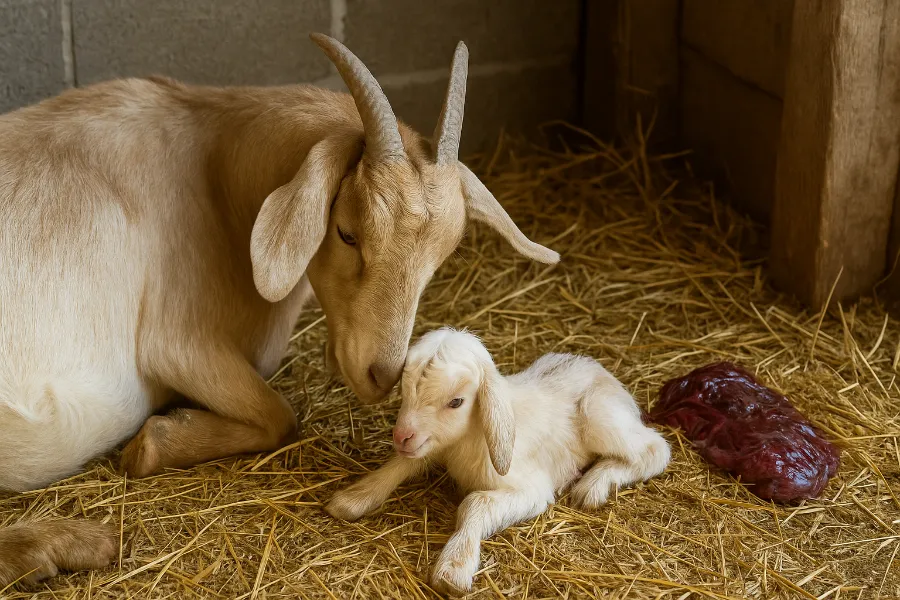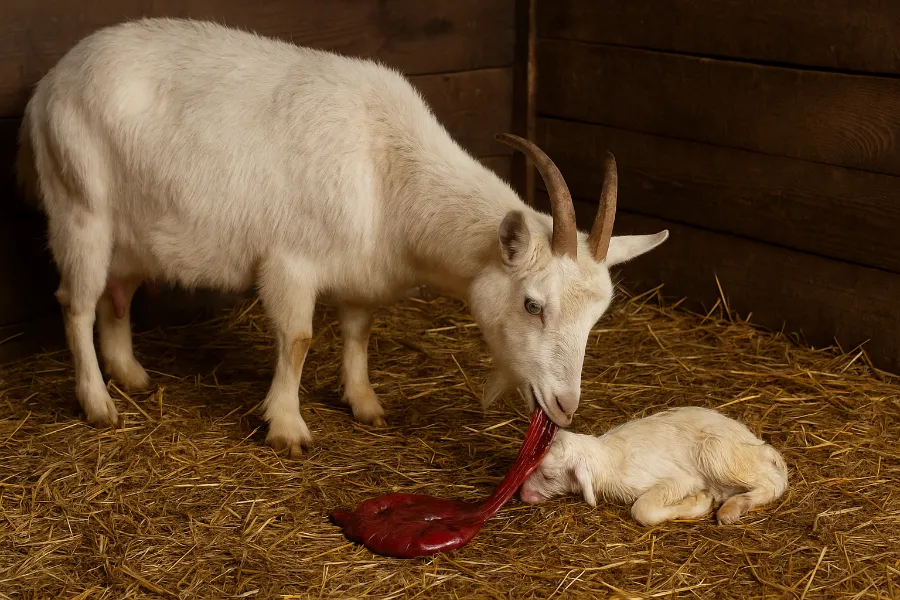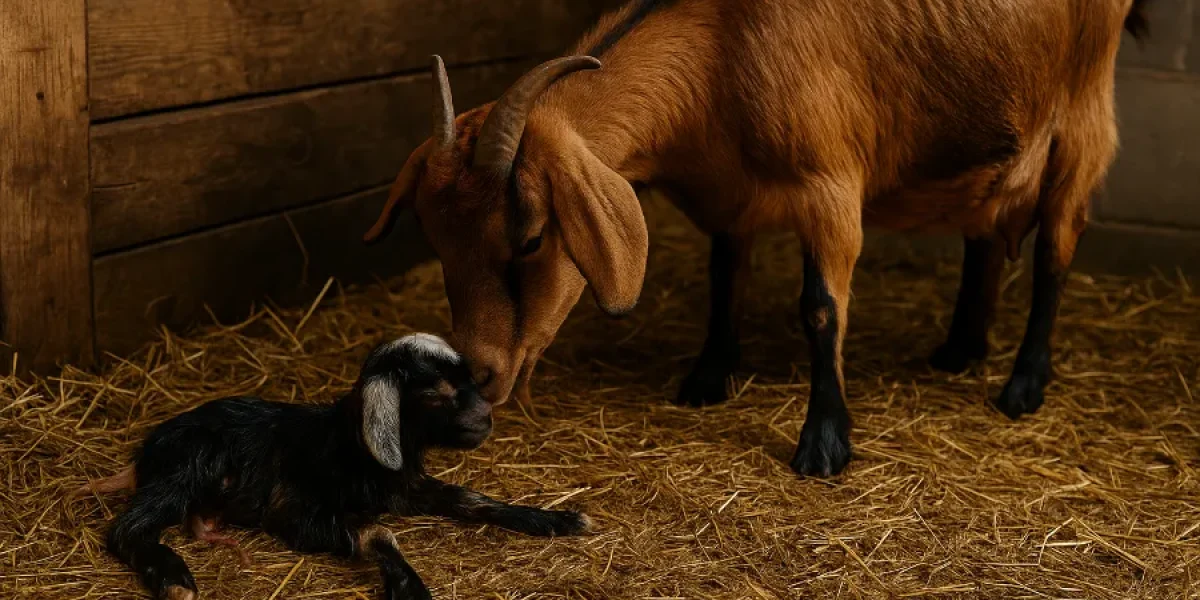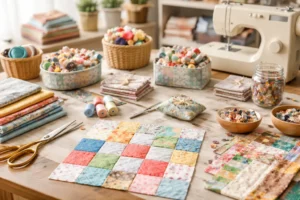Every kidding season reminds me that postpartum goat care after birth is where the real work begins. Once the kids hit the straw and the barn goes quiet, that’s when your instincts, preparation, and care shape the days ahead.
In those first few hours, your doe’s body shifts dramatically — her hormones crash, her uterus contracts, her udder fills, and her energy dips. Without proper care, she can easily slip into mastitis, ketosis, or infection. Over the years, I’ve learned that postpartum recovery is part science, part heart — blending traditional homestead know-how with new tools and supplements like goat electrolytes and goat probiotics to keep both doe and kids thriving.
Let’s walk through each part of postpartum recovery step by step — from the goat birthing moment to long-term goat wellness.
Goat Birthing: Setting the Stage for a Smooth Recovery
Preparation is everything. A calm, clean, and safe kidding space sets the tone for the entire postpartum journey. Before labor, I make sure my kidding area has:
- Fresh goat bedding (deep straw or wood shavings)
- Towels and gloves
- Warm water and molasses
- Iodine for cords
- A bucket of clean electrolyte mix
When goat birthing begins, I keep the space quiet. Once the doe goes into active labor, I watch — not hover. Most births progress naturally. When the kid is born, I clear its nose and mouth, dry it with towels, and place it near the mother’s head so she can lick and bond.
Within the first hour, I note how strong her contractions remain — this gives clues about whether the goat placenta will pass easily.
Goat Placenta: What to Expect and How to Help
After every kidding, I wait for that final step — the goat placenta to pass. Normally, it’s expelled within 6–12 hours after birth. When it drops naturally, I quietly remove it from the pen and replace the bedding.
If the Placenta Doesn’t Pass
If it’s been more than 12 hours and the placenta hasn’t appeared:
- Offer warm molasses water or an electrolyte drink.
- Walk the doe gently to stimulate contractions.
- Never pull or tug — that can cause uterine tearing.
- If it’s still retained after 24 hours, contact a vet.
A retained placenta often hints at calcium imbalance or infection risk. I’ve learned to keep injectable calcium on hand and always make sure the doe is eating and alert.
When the placenta passes cleanly and your doe starts nibbling hay again, you’re in the clear to focus on rebuilding strength.
Goat Electrolytes: The First Step Toward Recovery
After giving birth, every doe is dehydrated and mineral-drained. That’s where goat electrolytes make all the difference. I keep a warm bucket ready right after kidding.
My go-to recipe:
- 1 gallon of warm water
- 2 tablespoons molasses
- 1 teaspoon salt
- 1 teaspoon baking soda
- Optional: splash of apple cider vinegar
You can also use store mixes like Bounce Back or Nutri-Drench. The goal is hydration — not just water, but minerals that restore muscle and nerve function.
If the doe drinks deeply within that first hour, it’s a strong sign her recovery is on track. I’ve had tired does perk up minutes after their first sip. Electrolytes also prevent postpartum ketosis and milk fever — both silent threats in early recovery.
Goat Udder: The Window into Her Health
The goat udder tells me everything I need to know about how the body’s responding after birth. Within hours of kidding, I gently check for symmetry, temperature, and milk flow.
Healthy Udder Signs
- Soft and pliable texture
- Equal fullness on both sides
- Normal temperature (not hot or cold)
- Smooth, creamy milk or thick colostrum
I strip a few squirts from each teat to clear the wax plug and let colostrum flow freely. Kids need that access right away.
When Something’s Wrong
If one half of the udder feels hot, hard, or painful — you might be facing mastitis. Early checks prevent major problems later.
I once ignored a firm udder for a night and paid for it the next day with swelling and clumpy milk. Since then, I never skip those gentle udder exams in the first 24 hours.

Mastitis Goats: Catching and Preventing Infection
Mastitis can sneak up fast — it’s one of the biggest risks in postpartum goat care after birth.
Here’s what to watch for:
- Hard, hot udder half
- Watery or chunky milk
- Decreased appetite
- Fever or listlessness
Prevention
- Keep bedding clean and dry.
- Sanitize hands and teats before milking.
- Don’t overmilk early on — gentle and balanced stripping prevents irritation.
- Always use a post-milking dip (iodine or chlorhexidine).
If I suspect infection, I apply warm compresses and strip the udder every few hours. Severe cases require vet treatment and antibiotics.
Preventing mastitis is really about clean stalls and early attention — no gadget replaces that.
Newborn Goat Care: Protecting the Next Generation
While mom recovers, the kids demand all your focus. Newborn goat care starts the second they hit the straw.
Step 1: Breathing and Drying
Use towels to dry them off, clearing nostrils and stimulating circulation. In winter, I’ll set a safe heat lamp nearby — never too close to bedding.
Step 2: Colostrum
Colostrum is their first immunity shot. Each kid needs about 10% of its body weight in colostrum within the first 12 hours.
If the doe can’t nurse, milk her by hand and bottle-feed.
Step 3: Navel Dipping
Dip each umbilical cord in 7% iodine. This prevents infection and joint ill — a small step that saves a lot of heartache.
Step 4: Warmth and Observation
Kids chill easily. I line the pen with fresh straw, make sure they’re nursing, and note any weak ones.
Sometimes, I’ll supplement with a goat kid sweater on cold nights — it’s adorable and practical.
Goat Bedding: Comfort, Warmth, and Cleanliness
If there’s one secret to postpartum success, it’s this: clean goat bedding.
After every kidding, I pull the top layer of wet straw or shavings and replace it with a deep, clean layer.
Bedding Options
- Straw: Traditional and compostable.
- Pine shavings: Excellent absorption; avoid cedar (toxic oils).
- Rubber mats: Use under bedding for easy cleanup.
I also dust lightly with barn lime or diatomaceous earth to keep odors and bacteria at bay.
Fresh bedding means dry udders, warm kids, and fewer infections. On my farm, this daily habit has nearly eliminated postpartum hoof and udder problems.
Goat Probiotics: Restoring Digestion and Immunity
After kidding, a doe’s digestion often slows down — especially if she’s been off feed during labor.
This is where goat probiotics shine.
I usually give a dose of probiotic paste within 12 hours after birth, then again daily for 3–5 days. It helps repopulate gut flora, stimulate appetite, and strengthen her immune system.
If she’s sluggish or has soft stool, probiotics almost always help turn things around. I’ve even noticed improved milk flow and cud chewing within a day or two.
Fermented goat milk, kefir, or yogurt are also natural probiotic options for those who prefer a traditional route.
Goat Wellness: The First Week Routine
I see goat wellness as a rhythm — not a checklist.
Here’s how I handle the first five days after every birth:
Day 1: Stabilization
- Placenta passed
- Electrolyte drink offered
- Kids nursing
- Udder checked for firmness
Day 2: Strength Building
- Add grain and calcium-rich feed
- Check temperature (normal: 101.5–103.5°F)
- Massage udder and strip lightly
Day 3: Watch and Record
- Note milk yield and appetite
- Continue probiotics
- Refresh bedding
Day 4–5: Return to Routine
- Resume light grazing (weather permitting)
- Maintain hydration
- Record any lingering swelling or discharge
Consistent observation = faster recovery and better milk performance later in the season.
Traditional vs. Modern Postpartum Care
I’ve tried both — and the truth is, the best results come from blending old-school intuition with modern precision.
| Approach | Traditional Wisdom | Modern Tools |
|---|---|---|
| Hydration | Molasses & salt water | Pre-mixed electrolyte powders |
| Monitoring | Visual observation | Smart thermometers, stall cams |
| Udder Health | Hand-milking intuition | Mastitis test strips |
| Nutrition | Herbal tonics, kelp | Vitamin-mineral drenches |
| Hygiene | Fresh straw & lime | UV or drying mats |
Use technology to back up what your instincts already know. Nothing replaces time in the barn — but a temperature sensor can give peace of mind when you can’t be there.
Goat Recovery Red Flags

Even with the best care, complications can appear. Keep these quick indicators on your radar:
| Condition | Signs | Action |
|---|---|---|
| Retained Placenta | No placenta after 24 hrs | Vet check, oxytocin |
| Mastitis | Hot, hard udder | Strip, warm compress, antibiotics |
| Ketosis | Sweet breath, fatigue | Molasses, propylene glycol |
| Milk Fever | Tremors, weak legs | Calcium supplement |
| Metritis | Foul discharge, fever | Vet antibiotics |
Early action always beats late treatment.
Final Thoughts: The Heart of Postpartum Goat Care After Birth
When I think about postpartum goat care after birth, I think of quiet mornings in the barn — steam from warm water buckets, sleepy kids nestled under heat lamps, and a tired doe finally chewing her cud.
It’s a humbling process. Every towel, every check, every sip of molasses water counts. Whether you run a tech-savvy barn or a simple straw pen, your consistency and compassion are what truly heal your herd.
No machine replaces your presence, and no supplement outperforms patience.
That’s the beauty of goat keeping — a balance between old and new, heart and hands, instinct and innovation.
FAQs
It’s the period right after kidding when the doe recovers and her kids adjust to life outside the womb. Proper care ensures healing, milk flow, and healthy bonding.
Most does recover within 3–5 days, though full wellness can take up to two weeks. Regular hydration, electrolytes, and udder checks help speed recovery.
A healthy doe should pass the placenta within 6–12 hours. If it hasn’t passed in 24 hours, contact a vet immediately to prevent infection.
Keep bedding clean, wash hands and teats before milking, and use iodine teat dips. Early detection through udder checks prevents major issues.
Electrolytes restore minerals and fluids lost during birth. They boost energy, prevent dehydration, and support quick postpartum recovery.
Yes. Goat probiotics help restore gut balance, improve appetite, and strengthen the immune system, especially if the doe was under stress or given antibiotics.
Clean, dry straw or pine shavings work best. Avoid damp or soiled bedding—it can lead to udder infections and chills in newborn kids.













